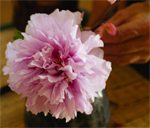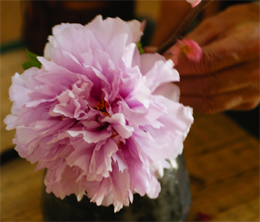“Knowing the theory is not the most important thing to approach the Way of Flowers. Ikebana is primarily about knowing how to observe the plants, meeting them to create beautiful compositions. For this, it is essential to carefully observe them and search for their most beautiful side. Throughout the practice of floral composition, one will strive to make contact with the flowers and, by conversing with them, savor this unique encounter. Everyone is an artist with a branch, if they know how to listen to it.”
Noriko Onda.
Whatever the school, the basic principles are always respected, such as the three essential lines forming a triangle in the bouquet, cutting the flower, or adjusting its inclination. Ikebana has become an art, but it is also and above all an art of living.
Today, there are as many as three thousand different schools, but three major schools dominate the Ikebana landscape:
- Ikenobô, the oldest, faithful to the asymmetrical triad and a certain spiritual idea,
- Ohara, which modernizes the Moribana style and reconnects with the landscaped aspect of Rikka by opening up to abstraction and colors,
- Sôgetsu, the least rooted in Japanese tradition, which calls more on the artist’s creativity and allows more freedom in the choice of forms and materials.
In Japan, life is closely tied to the rhythm of the seasons. The blooming of cherry blossoms, the reddening leaves of maples, camellias, irises are all occasions for celebrations.
The floral art arrived from China in the 7th century through the custom of floral offerings at Buddhist altars brought by Japanese envoys. One of them, Senmu, codified this floral art by advocating, instead of Chinese exuberance, the classical rigor of the trinitarian principle still found today in most Japanese bouquets. Retired in a small house near the pond of a temple in Kyoto (Ike-no-bô), Senmu taught the art of arranging flowers for offerings according to the rule: one high flower and two lower ones.
As early as the 12th century, Buddhist rites were also celebrated in private homes, and bouquets were arranged for non-religious festivities. The Sendenshô, a text gathering the original rules, then stipulated fifty-three arrangements for all occasions in life (marriage, a boy’s coming of age, a warrior’s departure…). It specifically excluded bouquets with four species and four colors because the word shi (four) is a homonym for the word meaning “death.” This principle has remained but is often justified by the rule of asymmetry alone.
The Kyoto temple tradition continued until the 15th century, and different styles developed according to the eras, the Rikka style and the Nageire style, lighter, more spontaneous, and natural under the influence of the tea ceremony. The art of bouquets achieved its recognition in the 17th century, and, after being the subject of rivalries and court intrigues in aristocratic exhibitions, it became democratized and also opened to women. In the 18th century, the Shoka style simplified rules by organizing the bouquet according to a trinitarian scheme: heaven, man, and earth.
In 1854, Japan opened up to commerce and Western culture. The political and artistic implications were considerable, and in the realm of Ikebana, the introduction of new flowers inspired new masters, including Unshin Ohara, who restored old traditional models like the Moribana style and founded his own school. Around 1920, young revolutionaries distanced themselves from traditional codifications and original Buddhist references. Influenced by modern abstract art, they began using non-living materials alongside natural ones. Thus, Sofû Teshigahara founded the Sôgetsu school.



